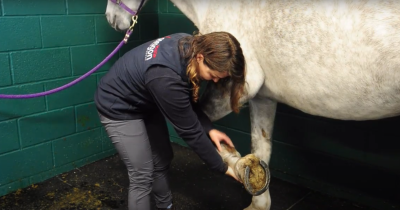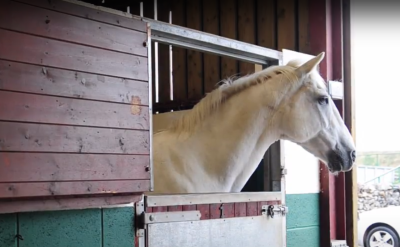
Laminitis is a painful condition affecting horses, ponies and donkeys. It occurs when the sensitive tissues (called laminae) that bond the hoof wall to the pedal bone within the hoof, become inflamed.
As well as being extremely painful, the pedal bone can sink or rotate within the hoof under the weight of the horse. Early detection and treatment are essential for the best outcome.
The clinical signs are; increased digital pulses, heat in the foot, weight shifting, reluctance to move, lameness (which commonly affects at least two limbs), pain when hoof testers are applied to the point of the frog, the horse leaning back onto its heels (to remove weight from the painful toe area) and in chronic cases divergent hoof rings.
What causes laminitis? There are many factors contributing to the development of laminitis. Some are not fully understood, but research is ongoing. We can group causes into three broad categories.
First, Endocrine/Hormonal Disease - conditions such as Cushing's (PPID) and Equine Metabolic Syndrome (EMS).
Second, diseases associated with inflammation – occasionally when whole body inflammation occurs it can lead to laminitis.
Third, mechanical overload/supporting limb laminitis – injuries or pain can cause shifting of more weight onto the non-painful legs causing increased strain.

Acute laminitis is a medical emergency and horses should be seen by a vet so that they can receive treatment as soon as possible.
A thorough history and clinical examination is usually sufficient to diagnose the problem. Further tests may be needed such as X rays or blood samples to assist diagnosis and plan correct treatment.
Pain management is achieved by medications. It is a good idea to box-rest the horse during the initial treatment. Foot support can be achieved by providing a deep bed or use of supports attached to the feet.
Short term, it is vital to avoid grass, and sugary food stuffs and treats. Poor quality hay (soaked to reduce carbohydrates) is the best option.

Prevention of laminitis is aimed at diet modification, controlled exercise, good foot care and management of underlying condition to reduce the chance of reoccurrence.
Feed poor quality hay (preferable to hayledge) restricted initially at 1.5% of the horse’s bodyweight to prevent excess weight gain/promote loss. Also, hay can be soaked to remove as much of the water-soluble carbohydrate as possible.
If extra feed is needed, fibre-based products that contain chaff or unmollassed/ low sugar options should be used. Low calorie balancers can also be used to help provide vitamins.
Horses should not have hard feed based on cereals as they are rich in carbohydrate or molassed sugary foodstuffs. And avoid treats!
Grazing should be managed carefully and strictly monitored especially in spring and summer. The use of grazing muzzles or restricted time turnout, and monitoring grass levels can help plan what suits the individual horses situation.
Regular hoof care maintains good foot balance and prevents excess stress on the foot. X-rays can be used to assist farriers and vets with corrective trimming where needed.
For horses with existing medical conditions such as EMS/Cushing's regular prescription checks by the vet are essential to ensure medications are working effectively.
Regular controlled exercise (appropriate to the individual horse) is important alongside weight management to prevent obesity. Excess weight strains the joints/feet as well as exacerbating conditions such as EMS.
Have you considered using a weigh bridge? Having an accurate weight is important with laminitis and overall horse health, including getting accurate drug doses, wormers and planning and monitoring diet progress. We have a weigh bridge at Paragon’s centre at Newbiggin near Penrith.